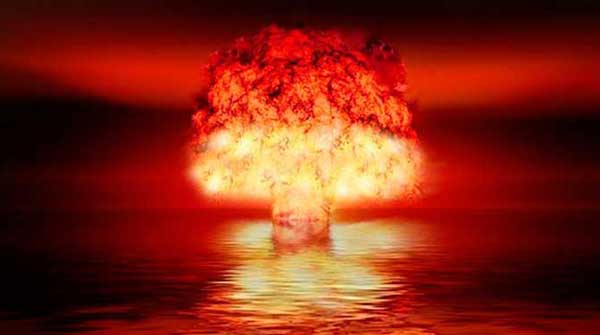Conflicting geopolitical realities: The new world order currently still coexists alongside the old world order
 As a child in the early 1960s, I recall being instructed by my public school teacher on how to assume the “turtle position” under my desk in case of an incoming nuclear missile. The Cuban missile crisis had brought the USSR and the United States to within a hair’s breadth of nuclear war over Cuba.
As a child in the early 1960s, I recall being instructed by my public school teacher on how to assume the “turtle position” under my desk in case of an incoming nuclear missile. The Cuban missile crisis had brought the USSR and the United States to within a hair’s breadth of nuclear war over Cuba.
Six decades later, we’re hearing echoes of similar nuclear madness. Russian President Vladimir Putin started it by making references to the possible use of nuclear weapons after encountering strong resistance to his invasion of Ukraine last year. Last week, he upped the ante by suspending Russia’s only nuclear arms control pact with the U.S., the New START agreement.
Others are piling on. Last week, the Alphen Group, a network of prominent European security thinkers, released A Comprehensive Strategy to Secure Ukraine’s Future. On nuclear weapons, it recommends that “responding in kind should remain an option”, though “a range of sub-nuclear responses should be designed, including a massive cyber-attack on Russian forces and/or the Russian Government or the possible destruction by conventional means of Russia’s ability to conduct the war.”
 |
| Related Stories |
| Hybrid warfare and the New Cold War
|
| Russia vs Ukraine: Is diplomacy dead?
|
| How the Russia-Ukraine War could escalate into a nuclear confrontation
|
What’s making diplomacy so difficult? It’s the challenge of resolving the core geopolitical contradiction: the new world order still coexists alongside the old world order. Great Powers and others still have the coercive power to assert national interests over international law.
Following the Second World War, the new world order was meant to operate on UN legal principles such as peoples’ self-determination and the inviolability of sovereign borders. “Spheres of Influence” was not at all a legally recognized principle.
During the Cold War, the U.S. and the Soviet Union carved out exclusive spheres anyway. Because of the cataclysmic potential of war between them, any competition could only occur by proxy in other countries, notably Korea, Vietnam and the Middle East. And it came dangerously close to disaster over Cuba.
Unfortunately, Great Powers and others still operate this way when it suits their interests. Ukraine is the latest case in point. Russia wants its neighbour Ukraine back inside its sphere, while NATO and its allies defend Ukraine based on modern legal principles. In the Russian version, NATO is a tool for expanding America’s own sphere of influence. It believes the west only invokes law when it suits our interests. Last week’s UN resolution calling for Russia’s complete withdrawal, supported by 141 countries, is ignored.
Russia points accusingly at American interventions around the world, and the U.S. points at Russia in Syria, Africa and elsewhere. While the Ukrainian people fight desperately for their security and freedom, neither side trusts the other enough to enter peace talks.
China adds a third challenge to diplomacy. It, too, plays the Spheres of Influence game when national interests are at stake. Its Belt and Road expansionism, dominance over Tibet, border clashes with India, oppression of the Uyghurs in Xinjiang, retaking of Hong Kong, claim to the entire South China Sea, and demand to possess Taiwan all fit the mould.
So can there be any hope for peace? Actually, yes. Ultimately, in waging proxy wars, nuclear powers normally see that peace is preferable to mutual annihilation.
Amid all the warmongering, peace signals have recently emanated from two very different sources. First, the Chair of the U.S. Joint Chiefs of Staff, General Mark Milley, reiterated his view that the conflict will almost certainly result in stalemate and end in negotiations.
Then, last week, China announced its own 12-point peace plan for Ukraine. Though it did not call for Russian withdrawal – and was thus dismissed by the Biden Administration – China’s plan did assert that “The sovereignty, independence and territorial integrity of all countries must be effectively upheld.” Ambiguous on other points, it declared that: “Nuclear weapons must not be used and nuclear wars must not be fought. The threat or use of nuclear weapons should be opposed.”
Coming just days after China also released its little noticed Global Security Initiative Concept Paper, it appears that the country is determined to take the high road on global peace. Unfortunately, with its threats against Taiwan, such positioning cannot be seen as entirely sincere. Indeed, China’s proposal came amid reports that it was considering supplying Russia with drones as the next step in deepening relations. Still, it was enough to encourage Ukrainian President Zelensky to start planning a visit to Beijing.
We must, nevertheless, remain wary of miscalculation when nuclear options are brandished.
U.S. President John F. Kennedy gave good advice after the Cuban crisis: “Above all, while defending our own vital interests, nuclear powers must avert those confrontations which bring an adversary to a choice of either a humiliating retreat or a nuclear war. To adopt that kind of course in the nuclear age would be evidence only of the bankruptcy of our policy–or of a collective death-wish for the world.”
The U.S. and Russia reached an accommodation over Cuba, which, to this day, remains a sovereign state just off the coast of Florida.
Unless we want our children hiding under school desks again, it’s time for the parties involved to begin concerted diplomatic efforts to avert further escalation and achieve peace and security for the Ukrainian people.
Randolph Mank is a former Canadian diplomat and business executive. He currently heads MankGlobal consulting, serves on boards, and is a Fellow of the Canadian Global Affairs Institute and the Balsillie School of International Affairs.
For interview requests, click here.
The opinions expressed by our columnists and contributors are theirs alone and do not inherently or expressly reflect the views of our publication.
© Troy Media
Troy Media is an editorial content provider to media outlets and its own hosted community news outlets across Canada.


